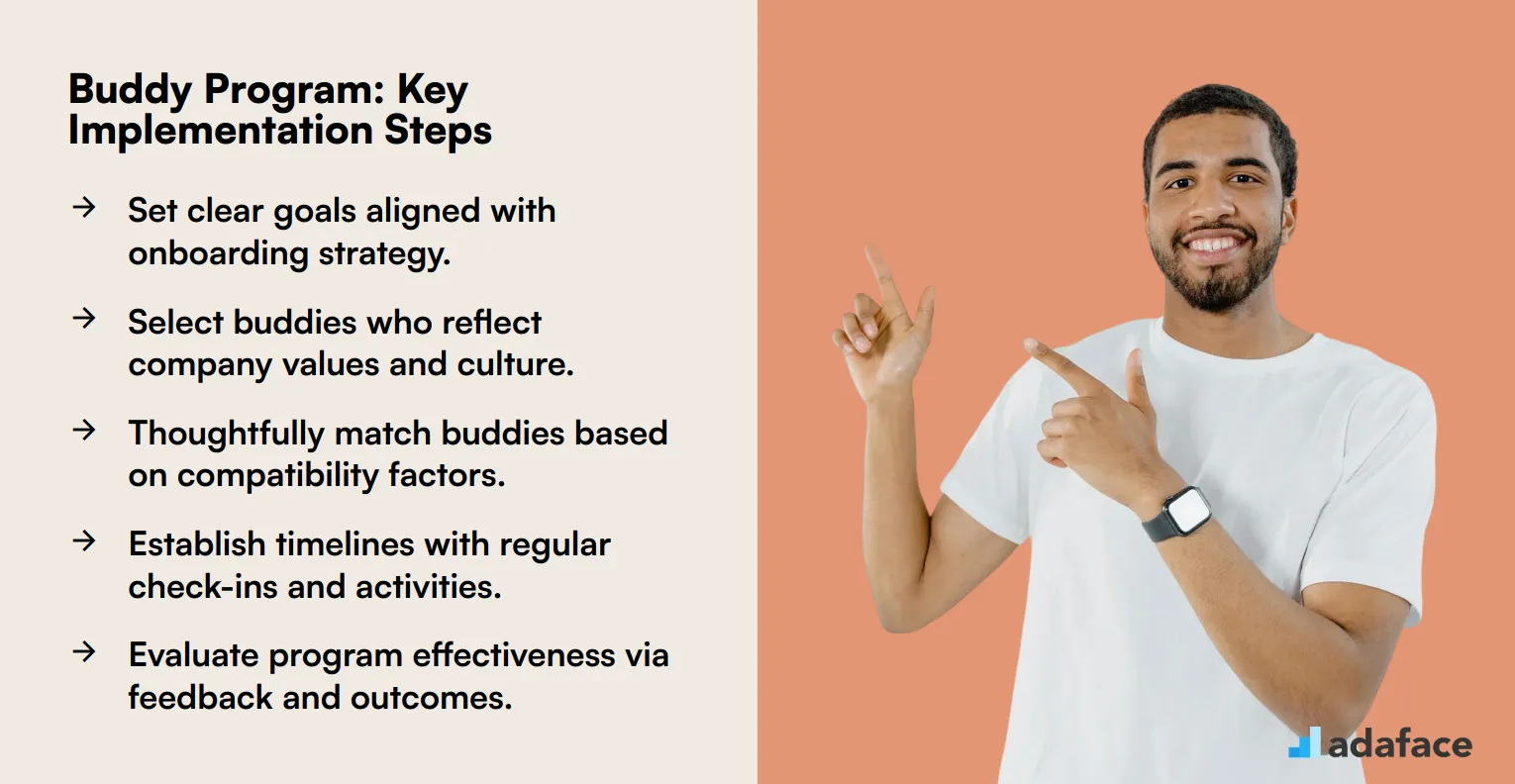A buddy program in recruitment is a system where new hires are paired with existing employees to help them integrate into the company culture. This approach not only eases the onboarding process but also boosts employee retention and satisfaction. Learn more about employee onboarding process.
Implementing a buddy program offers numerous benefits, such as enhancing communication and reducing turnover. By selecting the right buddy, companies can ensure that new employees feel supported and valued, which is crucial for long-term success.
Table of contents
What is a Buddy Program in Recruitment?
A buddy program in recruitment is a structured initiative that pairs new hires with experienced employees. This system aims to facilitate smoother onboarding and integration of new team members into the company culture and work processes.
The buddy, typically a peer or colleague from the same department, serves as a go-to person for the new employee's questions and concerns. They provide informal support, share insider knowledge about company norms, and help the newcomer navigate their new work environment.
Buddy programs can significantly reduce the time it takes for new hires to become productive and comfortable in their roles. They also foster a sense of belonging and connection, which can lead to improved employee retention and job satisfaction.
Implementing a buddy program requires careful planning and matching of buddies with new hires. It's important to select buddies who are enthusiastic about the role and have the time and skills to support their new colleagues effectively.
While buddy programs are beneficial, they should complement, not replace, formal onboarding processes. The buddy's role is to offer peer-level support, distinct from the responsibilities of managers or HR professionals in the onboarding journey.
Benefits of Implementing a Buddy Program
Implementing a buddy program in your organization can significantly enhance the onboarding experience for new employees. By pairing newcomers with experienced team members, you create a supportive environment that fosters learning and integration.
A buddy program helps new hires feel more connected to the company culture, which can improve retention rates. It also provides them with a go-to person for questions, reducing the learning curve and increasing productivity.
For recruiters and hiring managers, a buddy program can be an effective tool in candidate nurturing. It ensures that new employees receive personalized attention, which can lead to higher job satisfaction and better performance.
Moreover, buddy programs encourage knowledge sharing and collaboration, which can lead to innovative solutions and a more cohesive team. This collaborative approach can also enhance the overall employee assessment process by providing insights into a new hire's strengths and areas for improvement.
Incorporating a buddy program into your onboarding strategy can also support your employer branding. It demonstrates a commitment to employee development and well-being, making your organization more attractive to prospective candidates.
How to Choose the Right Buddy for New Hires
Selecting the right buddy for new hires is a critical step in ensuring a smooth onboarding process. The ideal buddy should be knowledgeable about the company culture, processes, and the new hire's role, while also possessing strong interpersonal skills.
When choosing a buddy, consider their experience level and tenure within the organization. Look for employees who have been with the company long enough to understand its inner workings but are still enthusiastic about their work and the company's mission.
Personality fit is another crucial factor in buddy selection. Choose someone who is approachable, patient, and has a positive attitude towards helping others. The buddy should be willing to invest time in guiding the new hire and answering their questions.
Consider the workload and availability of potential buddies before assigning them to new hires. Ensure that the chosen buddy has enough time to dedicate to their mentoring responsibilities without compromising their regular work duties.
It's also beneficial to match buddies and new hires based on shared interests or similar career paths. This can help foster a stronger connection and make the new hire feel more comfortable in their new environment.
Lastly, provide training and guidelines for buddies to ensure they understand their role and responsibilities. Clear expectations and support will help buddies excel in their mentoring role and contribute to a positive onboarding experience for new hires.
Steps to Set Up an Effective Buddy Program
Implementing an effective buddy program starts with clear planning and goal-setting. Define the program's objectives and duration, ensuring they align with your organization's onboarding strategy and culture.
Select and train your buddies carefully, choosing experienced employees who embody your company values. Provide them with guidelines on their role, responsibilities, and best practices for supporting new hires.
Match buddies with new employees thoughtfully, considering factors like department, job role, and personality compatibility. Communicate the program details to both buddies and new hires, setting expectations for their interactions and meetings.
Establish a structured timeline for the buddy relationship, including regular check-ins and activities. Encourage open communication and provide resources for both parties to make the most of their partnership.
Regularly evaluate the program's effectiveness through feedback from participants and measurable outcomes. Use this information to refine and improve the buddy program over time, ensuring it continues to meet the needs of new hires and the organization.

Common Challenges in Buddy Programs and Solutions
Buddy programs can face several challenges, impacting their effectiveness in onboarding new employees. One common issue is the mismatch of personalities between buddies, which can hinder communication and support. To address this, consider using personality assessments to pair individuals with compatible traits, ensuring a smoother relationship.
Another challenge is the lack of time and resources dedicated to the buddy program, which can lead to inconsistent experiences for new hires. Organizations can overcome this by setting clear expectations and allocating specific time for buddies to engage with newcomers. Providing training and resources to buddies can also enhance their ability to support new employees effectively.
Additionally, some buddies may not fully understand their role, leading to confusion and ineffective guidance. Clear guidelines and ongoing support from HR can help buddies understand their responsibilities and improve their mentoring skills. Regular feedback sessions can also be valuable, allowing both buddies and new employees to share their experiences and suggest improvements.
Lastly, keeping the buddy program engaging and relevant can be a challenge as the organization evolves. Regularly updating the program to reflect changes in company culture and objectives can keep it aligned with organizational goals. Encouraging feedback from participants can provide insights into areas for improvement, ensuring the program remains beneficial for all involved.
Measuring the Success of Your Buddy Program
Evaluating the success of your buddy program is key to ensuring it meets its intended goals. Start by setting clear objectives, like improving new hire retention or enhancing job satisfaction, and use these as benchmarks for success.
Collect feedback from both buddies and new hires to gain insights into their experiences and identify areas for improvement. Surveys or informal interviews can be effective tools for gathering this feedback, helping you understand what works and what doesn't.
Monitor key metrics such as retention rates, employee engagement scores, and onboarding timelines to measure the program's impact. These metrics can provide quantitative data that complements the qualitative feedback from participants.
Consider implementing periodic reviews of the buddy program to keep it aligned with organizational goals and evolving needs. Regular assessments allow for adjustments and enhancements, ensuring the program remains relevant and effective.
Finally, share the success stories and positive outcomes of the buddy program within the organization. Highlighting these successes can boost morale and encourage continued participation from both current and future employees.
Conclusion
In conclusion, a well-implemented buddy program can significantly enhance the onboarding experience for new hires, making them feel welcomed and supported. By carefully selecting the right buddy and addressing common challenges, you can create a positive and productive work environment.
Remember, measuring the success of your buddy program is key to understanding its impact and making necessary improvements. By doing so, you ensure that your recruitment process not only attracts top talent but also retains them effectively.
Buddy Program FAQs
To prevent employee ghosting, maintain open communication and provide a positive candidate experience. Regular updates and feedback can help keep candidates engaged.
Ghosting is on the rise due to increased job opportunities and communication channels. Candidates often have multiple offers, leading to less communication with non-preferred employers.
Key benefits include improved onboarding, enhanced employee engagement, and increased retention rates. A buddy program helps new hires feel welcomed and supported.
Choose a buddy based on compatibility with the new hire's role and personality. Consider factors like experience, communication skills, and willingness to mentor.
Common challenges include mismatched pairings and lack of engagement. Address these by providing training and clear guidelines for buddies.
Success can be measured through feedback surveys, retention rates, and employee satisfaction scores. Regular evaluations help ensure the program's effectiveness.

40 min skill tests.
No trick questions.
Accurate shortlisting.
We make it easy for you to find the best candidates in your pipeline with a 40 min skills test.
Try for freeRelated terms



